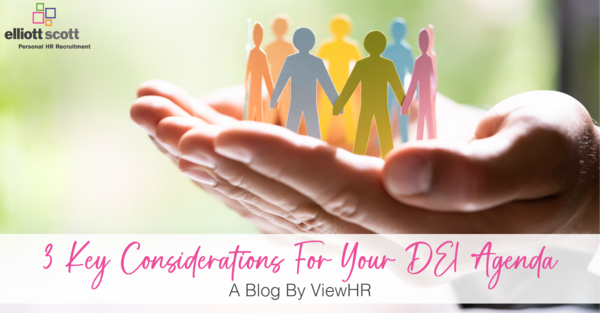Drop off your CV
We serve the global HR community through our offices located in Delhi, Hong Kong, London, New York, São Paulo and Singapore and have placed HR leaders in over 30 countries.
The Equality Act was introduced into law in the UK in October 2010[1], and so is fast approa...

The Equality Act was introduced into law in the UK in October 2010[1], and so is fast approaching its 12th birthday. As such, many employers are likely to have well-established policies and procedures in place, and will have undertaken employee training.
However, it is important to remember that diversity and inclusion are not just one-time topics. Although the Equality Act is still the most recent legislation; case law, research into good practice, and emerging trends mean that it is important to keep our knowledge up-to-date. In this blog, our partners View HR share with us some of the key topics they have been observing relating to diversity and inclusion in recent months.
Disability
It has always been the case under the Equality Act that employers must not discriminate on the grounds of a disability, and are required to make reasonable adjustments for those who may experience substantial disadvantage because of their disability compared with people who don't share the same disability[2]. However, recently there has been greater discussion around recognizing what constitutes as a disability. In particular, there has been a focus on hidden disabilities. According to the Office for National Statistics (ONS), around one in five people in the UK have disability[3], and a study by Leeds University estimates that around 70% of disabilities are “hidden”[4]. A hidden disability is one that may not be possible to physically observe.
A recent Parliamentary publication[5] gives examples of types of disabilities that may be hidden, including mental health conditions, sensory impairments, cognitive impairment, autism and Asperger syndrome, autoimmune diseases, and neurological disorders. The CIPD make a number of recommendations to ensure employees with hidden disabilities are appropriately supported, including awareness raising activities to challenge stereotypes (e.g. assumptions that all disabilities are visible due to the person being a wheelchair or Braille user), and implementing training specifically for line managers: “Disability ‘awareness’ training on its own is not enough: line managers need to know how to navigate conversations about disability and conditions with employees and understand how to arrange and implement reasonable adjustments.”[6]
Ethnicity
Research has shown worrying trends in relation to racism in the UK in recent years. The 2016 referendum to leave the European Union (EU) was followed by an increase in race and religious hate crime of 15-25% in England and Wales[7]. Academic research has concluded that Covid-19 led to an increase in hate crimes against Chinese people in London[8]. And in the 2019 – 2020 football season, there was a 53% increase in reported racial abuse in the professional game[9]. Although these figures do not specifically relate to the workplace, these are still trends that employers should be aware of, as people do not always keep their personal views on such matters outside of work.
The case of Allay (UK) Ltd v Mr S Gehlen[10], heard by the Employment Appeals Tribunal (EAT), is an important example of this. It was found that comments had been made to the effect that Mr Gehlen, who is of Indian origin, should work in a corner shop, and that he drove a Mercedes “like all Indians”. He had also been asked why he was in the country. Importantly, the original Employment Tribunal and subsequent EAT judgements found that staff equality training had become stale after 20 months. The employer’s failure to refresh the training meant it couldn’t rely on the “reasonable steps” defence to a race harassment claim.
Gender Identity
Have you received an email from somebody, and in their email signature it will say that their preferred pronouns are “she/her”, “he/him”, or “they them”? If this is not something you have noticed already, then we expect you will soon. There is a growing awareness of the importance of respecting how people wish to be referred to in relation to their gender identity. Some people may identify in a binary way (male or female), whereas others may consider themselves to be non-binary. This does not relate to people’s sexuality (i.e. who they are attracted to), but rather how they identify themselves. We have noticed an increasing number of client requests for training relating to respecting gender identities. If you would like to learn more about this topic, View HR have an informative blog available here: https://viewhr.co.uk/gender-reassignment-and-non-binary-gender-identification-what-rights-do-employees-have/ Given developments in these areas, we recommend that employers undertake a review of their policies and procedures to ensure that they are up-to-date, and that employees have received appropriate training and refreshers – including those who have joined recently, not just those who were employed when the Equality Act was first introduced!
This blog has been written by ViewHR. The ViewHR team are on hand to support employers with guidance and training in issues relating to diversity and inclusion.
If you are an employer and would like support in this area, please contact a member of the ViewHR team today for an initial discussion: hr@viewhr.co.uk | +44(0)1425 205390 | viewhr.co.uk.
ViewHR are UK based and provide flexible HR support and guidance combined with employment law consultancy.
[1] https://www.gov.uk/guidance/equality-act-2010-guidance#:~:text=Equality%20Act%20provisions%20which%20came,work%2C%20education%2C%20associations%20and%20transport [2] https://www.citizensadvice.org.uk/law-and-courts/discrimination/what-are-the-different-types-of-discrimination/duty-to-make-reasonable-adjustments-for-disabled-people/#:~:text=The%20Equality%20Act%20says%20there's,more%20than%20minor%20or%20trivial. [3] https://www.ons.gov.uk/peoplepopulationandcommunity/healthandsocialcare/disability/articles/nearlyoneinfivepeoplehadsomeformofdisabilityinenglandandwales/2015-07-13 [4] https://disability-studies.leeds.ac.uk/wp-content/uploads/sites/40/library/brookes-NUJ-Hidden-disabilities-Report-plus-Lena.pdf [5] https://post.parliament.uk/approved-work-invisible-disabilities/ [6] https://www.cipd.co.uk/knowledge/fundamentals/emp-law/disability-discrimination/factsheet#gref [7] https://www.economicsobservatory.com/did-the-vote-for-brexit-lead-to-a-rise-in-hate-crime [8] https://journals.sagepub.com/doi/full/10.1177/10439862211027994 [9] https://www.kickitout.org/pages/faqs/category/reporting-statistics [10] https://www.gov.uk/employment-appeal-tribunal-decisions/allay-uk-ltd-v-mr-s-gehlen-ukeat-slash-0031-slash-20-slash-at